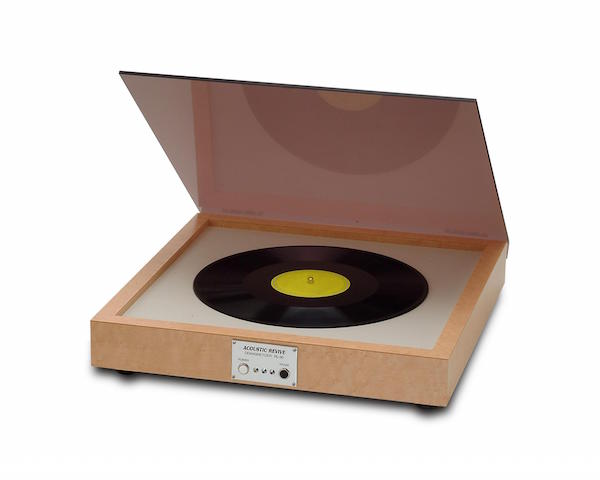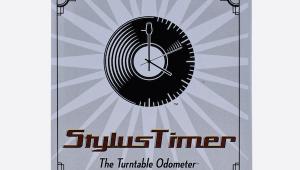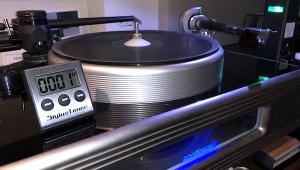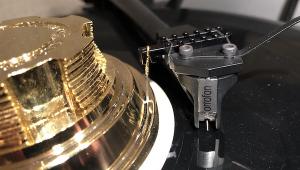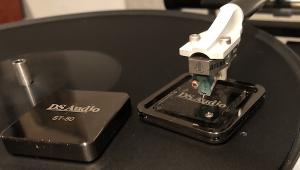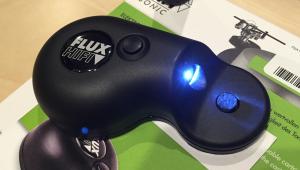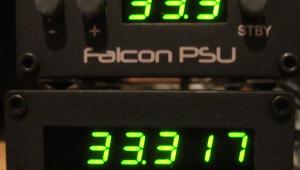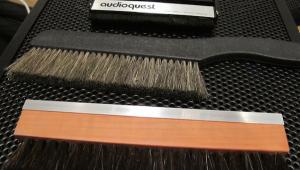You Can’t Demagnetize Vinyl But You Can Demagnetize a Record: The Furutech (alpha) and the Stein Music DE3 Record Demagnetizers
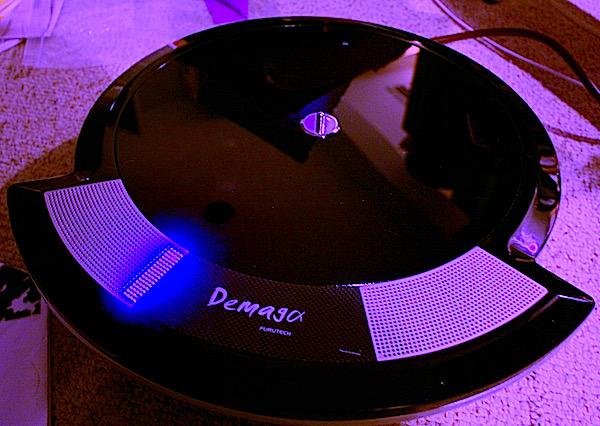
The claim that you could demagnetize a vinyl record seemed to me so ridiculous I had been putting off the time-wasting trial but with Ken in-house, we could both put to rest this latest bit of audio ridiculousness. He was up for the listen.
I unboxed both and then we had to pick a record.
For some reason I can no longer recall we both agreed upon Marti Jones’s still delightful and very well recorded and produced Used Guitars (A&M SP-5208), issued in 1988 and mastered by Greg Calbi at Sterling Sound. It’s hardly collectible at this time so if you see a copy, give it a spin!
We played the opening track “Tourist Town” and a few more noting the generally excellent recording tinged with a bit of the expected edge. “Okay Ken,” I said lacing it with a dollop of sarcasm, “let’s demagnetize a record”. I even managed air quotes with my hands as I said the word “demagnetize”.
I put the record on the Furutech’s spindle, hit the “on” button and waited for the completion of the automatic de-mag cycle.
The volume was untouched of course and I again lowered the stylus onto the record. Both of us sat there in (audio cliché alert) stunned disbelief.
This play sounded completely different from the previous one: it was smoother, less ‘etchy’ and produced greater depth and instrumental three-dimensionality. It was not at all subtle.
We tried more records, some of which produced equally obvious sonic improvements, others of which did not seem to sound any different, while other sounded only slightly better. But the ones that were greatly improved were dramatically better.
This was not what we were expecting. Of course you can’t demagnetize a piece of vinyl. It’s plastic and incapable of holding a magnetic charge. But as we found out, records, though made of PVC (polyvinyl chloride) can be demagnetized. Furutech’s explanation is that the compounds used to turn black transparent PVC contain ferrous materials that can become magnetized. In addition it’s claimed that label pigments also contain trace ferrous materials.
Furutech provides this documentation:
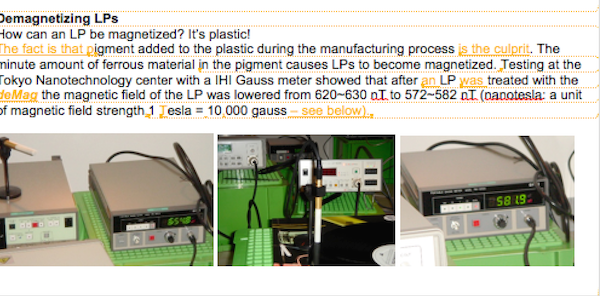
Regardless of the reason for this phenomenon, it’s difficult to argue against its existence. I’ve repeatedly demonstrated record demagnetization to skeptics and everyone hears it!
One such skeptic was Classic Records’s Mike Hobson who paid a visit and asked for a demo using one of his releases. Hobson was beyond skeptical. He was seriously skeptical.
We used the Masked and Anonymous soundtrack album (Columbia C2K 90618-1) that Classic had issued in 2003 on two 200g LPs. The movie stars Bob Dylan as Jake Fate, a fallen rock star sprung from jail to play a benefit concert. Dylan sings new versions of a few songs and there are covers too, including an absolutely incendiary version of “Gotta Serve Somebody” performed by the great gospel singer Shirley Caesar. We used that track for the “before and after”. Caesar’s voice “after” had far less edge, which left greater depth of vocal textures.
Hobson left so convinced by what he heard that he formulated “Clarity Vinyl”, which contained no black pigment. When he later listened to the same record pressed on black vinyl and Clarity Vinyl, it confirmed for him at least that the pigment was the “bright-edgy” culprit—especially after demagnetizing the black record made it sound similar to the Clarity Vinyl version.
Hobson later sent me two versions of Classic’s excellent reissue of Leo Kottke’s 6 and 12 String Guitar—one on black Quiex SV-P vinyl and one on Clarity Vinyl—and the sonic differences were obvious until I demagnetized the black one (by then I’d purchased the Furutech demagnetizer).
Hobson was so impressed, his audio distribution company EliteAV began distributing the Furutech Demag and still does.
Yes, but where’s the scientific “proof”. I hear you. Enter audio skeptic and ABX blind testing adherent Arny Krueger (you can read and listen to here an “objectivist”/”observationalist” debate between Krueger and Stereophile editor in chief John Atkinson) and his hydrogenaudio.org minions who mocked my and Ken’s observations and basically demanded measured proof!
So I offered some. I said I’d digitize a tune, then demagnetize the record and again digitize it and send them the files for spectrum analyses. They agreed and I did it. And guess what? The spectrum analysis showed an altered high frequency balance that well-comported with what Ken, I and many others have reported after demagnetizing records: the high frequency portion of the spectrum was lower in level after demagnetization.
End of story, correct? Of course not! These people are not interested in either observational analysis leading to scientific discovery or even measurements that disprove their dogmatic religious beliefs masquerading as science.
Even though I’d jumped through their flaming hoops and passed their test, they were back claiming their own challenge was flawed. You, see, the reason the high frequencies were lessened on the second playback was probably due to “high frequency wear” caused by the second play.
Now, in scientific terms, that is called “pure, unadulterated bullshit”, because as I’ve also demonstrated to skeptics, for example, that my original pink label Island copy of Jethro Tull’s Stand Up that’s been repeatedly played since 1969 still has better high frequency extension than any CD version. The claim that one play would so alter a record's high frequency performance was ridiculous.
But anyway, they Hydrogen Audio guys, having lost, were, like good little terrorists, back with new demands: the only way to scientifically demonstrate that record demagnetization produced measurable results (never mind that it’s easily audible!), was to do this: get three copies of the same record pressed contiguously (in other words three in a row pulled from a record press), and then?
And then I forget exactly what I was supposed to do with them because I really didn’t care what they thought then and I still don’t now because I was then 100% certain that had I followed their procedure and had the results again demonstrated a measured spectrum difference, they’d again come up with a reason to dismiss the results. Like “The Amazing Randi”, that is how these phonies operate.
However, I do have friends in high places at record pressing plants, so a number of years ago I managed to get three records pulled in order off a record press.
The record is Pat Metheny’s Orchestrion (Nonesuch 516668-1), a three-sided, double LP set with a blank side four. I've had them here for a few years now but never bothered to use them for any kind of testing. Until now.
So just for the heck of I devised my own test: I demagnetized one using Furutech’s newest Demag device ($3000), another using the Stein DE3 demagnetizer ($3200) and I left the third record untouched by demagnetic hands. And then I played them—first the un-demagnetized record.
Behind Metheny’s electric guitar are a series of “orchestrions”—mechanical, player-piano type acoustical instruments all controlled by Metheny’s guitar-produced instructions. Recorded in a pleasingly reverberant Brooklyn Church, the combination of exotic, distant and somewhat reverberant instruments fronted by a mellow, sonorous electric guitar, produced little in the way of etch or brightness.
If I didn’t hear differences I was fully prepared to write that. The untreated record didn’t sound bright. The various bell-toned percussive accents and cymbal crashes sounded more rich and mellow than edgy.
Switching to the Furutech version produced no tonal surprises, but Metheny’s guitar sounded better focused and organized and the orchestrionic instruments also sounded better-focused, all emanating from a blacker background and more focused in space. Same with the Stein version. I then went back to the non-treated record and it was definitely less well-organized spatially with diminished instrumental focus.
Was this difference worth $3000? No. However, I find that demagnetizing old records produces a far more significant sonic improvement, particularly records that contain vocal performances or a lot of brass. A friend once brought over an old 1950s era Billy Eckstine record. We played it and it really sounded in need of a demag. He said, “What I love about this record is that 1950s-sounding patina around his voice”. I said “The record demagnetizer over there will probably remove that.” He was skeptical but said “go ahead”. I demagnetized the record and the “patina” was gone.
That’s all I’m writing about this in terms of the effect. As for the two products, I’ll first cover the Furutech, because an earlier version of it (the one I own) came first. The new version is said to use a more powerful demagnetization system. It’s far better built than the original or even the first generation replacement with identical cosmetics and functionality. Like the original, the new one sits on three tall spikes. The foolishly placed front mounted IEC AC jack is now smartly located on the unit’s bottom, necessitating an “L” shaped IEC plug, which is supplied attached to a power cord. If Furutech claims the cord makes a difference I will become violent. The former IEC jack location now houses the “on/off” switch.
In place of the original’s push buttons are a pair of LEDs one on either side of the logo. The blue one on the left glows upon power up. A green LED glows upon touching the area to the logo’s right, which begins the demag process. That’s it. To use, place a record on the spindle and push the button.
The Stein Music LP Conditioner
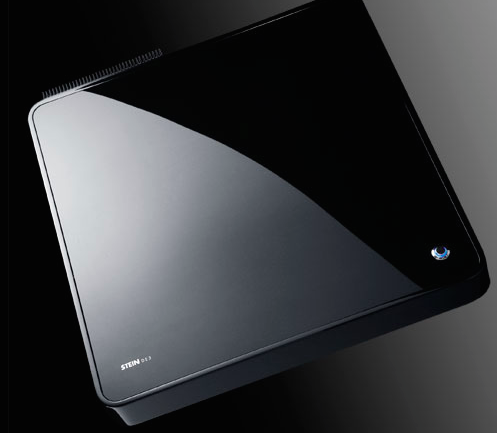
The Stein unit is a basic black square, glossy, and attractively finished, approximately 16.5x16.5 inches, with a single chromed push button located in the square’s right hand corner. A heat sink at the unit’s rear let’s you know Mr. Stein means business. Power is supplied by an outboard “Wall-wart” that connects via a small jack next to the heat sink.
No spindle means you can put more items on the surface to demagnetize such as CDs, cables or your pet Gerbil. I didn’t try CDs, cables or Gerbils for that matter because we’re only interested here in vinyl, but feel free to experiment.
Push the button and it glows blue while a high frequency whistle alerts you that the demag process is underway. When it stops and the blue light extinguishes, it’s done.
A Conclusion Is it worth spending $3000 on a record demagnetizer? Not if your choice is that or a new $3000 cartridge, of course. Could I tell that one of these two products was better at this task than the other? No, I couldn't. This is only for those who can afford to indulge in what some would call a delusion and other would call a useful, easily audible “tweak” that improves the sound of many records.
For instance I have a Japanese Toshiba-EMI pressing of Exile on Main Street that’s bone jarringly bright. I haven’t played it in a long time because the American Artisan-mastered original is so much better. I took it out and played it and, yup, it’s bright with not much bass, but after demagnetizing it, the harshness and brightness diminished, making it more listenable but still not great.
I admit to not using my unit for every record but if I play an old favorite and it has that certain “patina” I do use it and more often than not, the record becomes far more enjoyable. If you can afford one, a record demagnetizer is a useful tool in the analog playback arsenal.
I think these should be sold with a money-back guarantee. I don't think many would be returned.
By the way, the Acoustic-Revive RL-30 ($2495) is still available and distributed domestically by the Lotus Group, which claims the Acoustic-Revive unit was the first such device.
